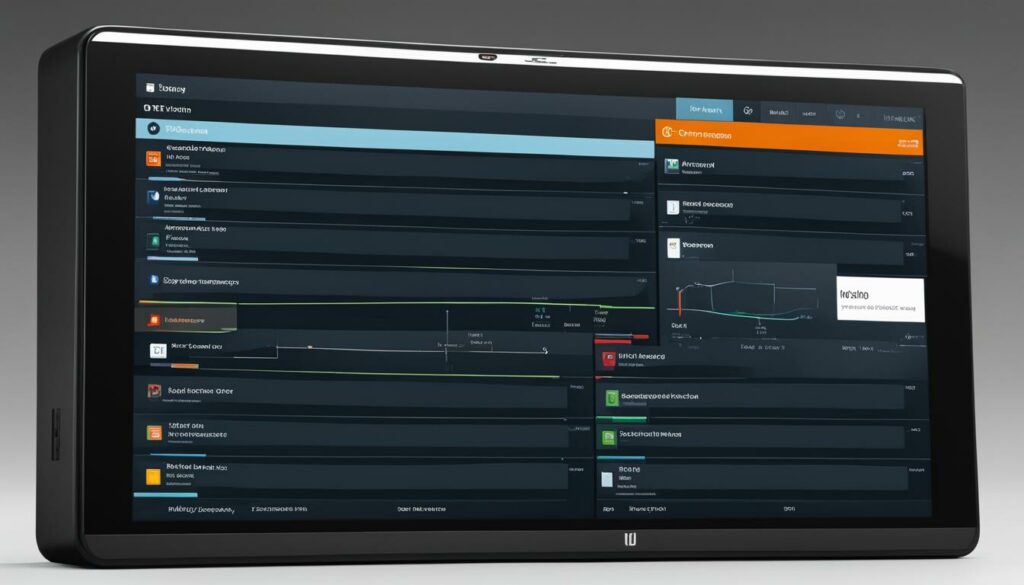Welcome to our article on high availability in web hosting. In today’s digital age, having a reliable and scalable website hosting solution is essential for businesses of all sizes. High availability ensures that your website remains accessible and operational at all times, minimizing downtime and maximizing customer satisfaction.
At the heart of high availability is data center solutions that prioritize redundancy. By duplicating critical components and functions within the system, you can enhance reliability and protect against potential failures that could disrupt your business. Redundancy measures, such as redundant servers, storage, cooling systems, networks, and power supplies, ensure continuous operation even in the face of component failure.
Companies like Liquid Web exemplify high availability through their multi-layered approach to redundancy in their data centers. Additionally, data center tiers, ranging from Tier 1 to Tier 4, define the level of redundancy and availability of a data center, providing businesses with various options to meet their specific needs.
Key Takeaways:
- High availability in web hosting is crucial for maintaining business continuity and minimizing disruptions.
- Redundancy in data centers is a key strategy for achieving high availability.
- Data center tiers define the level of redundancy and availability of a data center.
- Companies like Liquid Web prioritize high availability through their multi-layered approach to redundancy.
- Website owners can choose from different redundancy models, such as N+1, 2N, and 2N+1, depending on their requirements.
The Importance of High Availability in Web Hosting
High availability is critical for ensuring the continuous operation and accessibility of websites and applications. It minimizes downtime and the risk of system failures, which can have severe financial and reputational consequences. High availability builds customer trust and satisfaction by providing a seamless experience and uninterrupted services.
When it comes to website hosting, reliability is key. Customers expect their websites and applications to be available at all times, and any downtime can lead to frustration, financial loss, and a loss of customer trust. Uninterrupted business continuity is essential for maintaining a positive user experience and ensuring customer loyalty.
System failures can occur due to various reasons, such as hardware malfunctions, software bugs, or network issues. In such instances, high availability hosting plays a crucial role in minimizing the impact of these failures. By implementing redundancy measures and utilizing data center solutions, high availability hosting ensures that if one component fails, another can immediately take over without affecting the overall performance of the system.
“High availability hosting is like having a backup plan in place for your website. It gives you peace of mind knowing that even if something goes wrong, your services will remain operational, and your customers will be able to access your website without any disruptions.”
Redundancy in data center solutions acts as a fail-safe mechanism to prevent system failures from causing widespread disruptions. By duplicating critical components like servers, storage, cooling, network, and power supplies, data center solutions ensure uninterrupted business continuity and protect against financial loss.
Moreover, high availability hosting improves the reliability and efficiency of web hosting operations. It enables continuous service availability and minimizes the chances of prolonged downtime, which can significantly impact businesses and result in revenue loss. A reliable hosting infrastructure guarantees that websites and applications are accessible to users 24/7, maximizing their availability and reaching a wider audience.
Maximizing Customer Trust and Minimizing Financial Loss
Customer trust is vital for the success of any online business. When customers encounter a website that is frequently down or experiences performance issues, they are likely to lose confidence in the brand and seek alternatives. High availability hosting ensures that your website is reliable and always accessible, building trust and satisfaction among your customers.
Financial loss is another significant consequence of system failures and downtime. Businesses not only lose potential revenue during periods of downtime but also face the risk of losing loyal customers to competitors. Investing in high availability hosting minimizes these financial risks by ensuring uninterrupted service and maximizing uptime.
Overall, high availability hosting is not just a luxury; it is a necessity in today’s competitive online landscape. It safeguards against system failures, improves customer trust, and minimizes financial loss. By prioritizing high availability hosting and implementing robust redundancy measures, businesses can ensure the continuous operation of their websites and applications, providing a seamless experience for their customers and maintaining a competitive edge.+
Redundancy Models for High Availability Hosting
Redundancy models play a crucial role in achieving high availability in web hosting, ensuring uninterrupted service and minimizing the risk of disruptions. Implementing the right redundancy model for your hosting infrastructure is essential to meet the demands of your business and provide a reliable online experience for your users.
The N+1 Model: Cost-effective Reliability
The N+1 model offers a cost-effective approach to redundancy by providing an additional backup component for every “N” components required to run the system. This model ensures system performance even in the event of a single-component failure. With N+1 redundancy, you can maintain high availability without compromising cost-effectiveness.
The 2N Model: Enhanced Fault Tolerance
For organizations that require higher levels of reliability and fault tolerance, the 2N model provides complete replication of the critical system. It involves doubling the number of components needed, ensuring two sets of components are available for each one required. This redundancy model offers enhanced fault tolerance, allowing your infrastructure to withstand multiple simultaneous failures without service interruption.
The 2N+1 Model: Maximum Reliability
The 2N+1 model takes redundancy to the next level by adding an extra layer of protection. In addition to complete replication of the critical system, this model includes an additional backup component, providing even greater fault tolerance and reliability. While the 2N+1 model offers the highest level of redundancy, it comes with higher costs and increased spatial and infrastructure requirements.
| Redundancy Model | Key Features |
|---|---|
| N+1 | Cost-effective approach |
| 2N | Complete replication of the critical system |
| 2N+1 | Extra layer of protection |
Choosing the right redundancy model depends on various factors including cost-effectiveness, reliability requirements, scalability, and maintenance considerations. Assessing your financial and spatial requirements can help determine the most suitable redundancy model for your high availability hosting needs.

Implementing the appropriate redundancy model is crucial for maintaining high availability in your web hosting infrastructure. Whether you opt for the cost-effective N+1 model, the enhanced fault tolerance of the 2N model, or the maximum reliability of the 2N+1 model, redundancy ensures uninterrupted service and reduces the impact of component failures. Selecting the right redundancy model aligns with your business objectives and provides a solid foundation for a reliable, scalable, and high-performance hosting environment.
Achieving High Availability in Web Hosting
Ensuring high availability in web hosting requires implementing effective redundancy measures across various components. Redundancy plays a key role in minimizing downtime and maximizing uptime, providing uninterrupted service and optimal performance.
Server Redundancy
Server redundancy is a fundamental aspect of high availability hosting. By maintaining duplicate servers, the system can seamlessly transition to the backup server if the primary server experiences a failure. This ensures minimal disruption to service and consistent accessibility for users.
Storage Redundancy
Redundant storage systems are essential for safeguarding data and facilitating quick recovery. By utilizing redundant storage configurations, such as RAID (Redundant Array of Independent Disks), data can be distributed across multiple drives, minimizing the risk of data loss and enabling efficient restoration in the event of a hardware failure.
Cooling Redundancy
Overheating can lead to system failures and performance degradation. To mitigate this risk, redundant cooling systems are deployed in data centers. By utilizing multiple cooling units, any failure or maintenance activity can be managed seamlessly, ensuring that the servers and other critical infrastructure remain at optimum operating temperatures.
Network Redundancy
Network redundancy is crucial in maintaining continuous connectivity and minimizing the risk of disruptions. Multiple network connections from different providers, redundant switches, and routers ensure failover capability and provide alternative paths for data transmission. In the event of a network failure, traffic can be seamlessly rerouted, minimizing downtime and ensuring continuous service availability.
Power Redundancy
Power outages can cause significant disruptions to web hosting services. Implementing redundant power supplies, such as uninterruptible power supply (UPS) systems and backup generators, contributes to high availability. These redundant power sources ensure that servers and other critical infrastructure remain operational, even in the face of power disruptions.
By implementing multi-layered redundancy measures across servers, storage, cooling, network, and power systems, web hosting providers can achieve high availability with maximum uptime. These redundancy measures are crucial in minimizing downtime, preventing data loss, and ensuring uninterrupted service for businesses and their customers.

Implementing redundancy measures is vital to achieving high availability in web hosting. Server redundancy, storage redundancy, cooling redundancy, network redundancy, and power redundancy all contribute to maintaining uninterrupted service and maximizing uptime. By investing in multi-layered redundancy, web hosting providers can ensure a reliable and seamless experience for their customers.
Best Practices for High Availability in Web Hosting
Implementing high availability in web hosting requires following best practices to ensure uninterrupted service and mitigate potential risks. By incorporating backup and recovery strategies, clustering, failure detection systems, load balancing, disaster recovery, and fault tolerance mechanisms, you can enhance the reliability and resilience of your hosting infrastructure.
Backup and Recovery
Having robust backup and recovery processes in place is essential to protect against system failures and enable quick restoration. Regularly backup your data and establish efficient recovery procedures to minimize downtime and data loss. Consider automating backups and testing the recovery process to ensure its effectiveness in real-world scenarios.
Clustering
Clustering allows you to distribute workload across multiple servers and provides failover capabilities, ensuring continuous application services. By grouping servers together, you can enhance performance, scalability, and fault tolerance. Clustering can automatically transfer workloads to healthy servers if a fault is detected, reducing the impact of hardware or software failures.
Failure Detection
Implementing failure detection systems enables you to proactively monitor the health of your infrastructure and detect potential issues before they cause significant disruptions. By using automated monitoring tools and alerts, you can quickly identify and address failures, minimizing downtime and ensuring prompt resolution.
Load Balancing
Load balancing helps distribute network traffic across multiple servers or instances, preventing overloading and improving performance. By evenly distributing workloads, load balancing enhances resource utilization and ensures efficient handling of incoming requests. This reduces the risk of downtime or slow response times due to a single server becoming overloaded.
Disaster Recovery
Disaster recovery strategies are essential for minimizing the impact of catastrophic events on your web hosting infrastructure. By building redundant systems and implementing disaster recovery plans, you can recover from significant disruptions more quickly. This may involve replicating data to off-site locations and having alternative power sources or backup servers readily available.
Fault Tolerance
Fault tolerance measures ensure that your hosting infrastructure can continue operating even in the face of failures. Redundant components, such as multiple power supplies, network connections, and storage devices, can provide failover capabilities and prevent single points of failure. Investing in fault-tolerant hardware and implementing appropriate redundancy measures can significantly improve the availability and reliability of your web hosting.

| Best Practices for High Availability in Web Hosting | Key Benefits |
|---|---|
| Backup and Recovery | Protection against data loss and minimal downtime during system failure. |
| Clustering | Improved scalability, performance, and instant failover capabilities. |
| Failure Detection | Early detection of issues and prompt resolution to minimize disruptions. |
| Load Balancing | Efficient distribution of network traffic and improved response times. |
| Disaster Recovery | Minimized impact of catastrophic events and faster recovery. |
| Fault Tolerance | Reduced risk of single points of failure and improved system reliability. |
Conclusion
High availability hosting is essential for maintaining seamless service, minimizing downtime, and ensuring customer satisfaction. By implementing redundancy measures such as server redundancy, storage redundancy, cooling redundancy, network redundancy, and power redundancy, businesses can safeguard against single points of failure and enhance reliability. Redundancy models like N+1, 2N, and 2N+1 provide different levels of fault tolerance and reliability, allowing businesses to choose the most suitable option based on their needs and budget.
Additionally, implementing best practices like backup and recovery, clustering, failure detection, load balancing, and disaster recovery further optimize high availability in web hosting. These strategies help businesses protect their data, detect and address system failures quickly, distribute network traffic efficiently, and recover swiftly from disasters.
By prioritizing high availability in their web hosting, businesses can maximize uptime, minimize financial losses, and provide an uninterrupted and satisfying experience for their customers. Investing in high availability hosting demonstrates a commitment to reliability, fault tolerance, and customer satisfaction, which are key factors for success in today’s digital landscape.
FAQ
Q: What is high availability hosting?
A: High availability hosting refers to the practice of ensuring continuous operation and accessibility of websites and applications. It minimizes downtime and the risk of system failures, offering uninterrupted services to customers.
Q: Why is high availability important in web hosting?
A: High availability is crucial in web hosting as it minimizes disruptions, reduces financial losses, and builds customer trust and satisfaction. It ensures that websites and applications are accessible at all times, providing a seamless user experience.
Q: What are redundancy models in high availability hosting?
A: Redundancy models, such as N+1, 2N, and 2N+1, are used to achieve high availability in web hosting. These models involve duplicating critical components or functions within a system to enhance reliability and fault tolerance.
Q: How can I achieve high availability in web hosting?
A: Achieving high availability in web hosting involves implementing redundancy measures across various components, such as servers, storage, cooling, network, and power supplies. By ensuring backup systems and failover mechanisms, you can maintain uninterrupted service and maximum uptime.
Q: What are the best practices for high availability in web hosting?
A: Best practices for high availability include implementing backup and recovery strategies, clustering for instant failover, failure detection systems, load balancing to distribute network traffic, and comprehensive disaster recovery and fault tolerance strategies.
Q: Why is high availability important for business websites?
A: High availability is important for business websites as it ensures uninterrupted service, minimizes downtime, and protects against financial losses. It builds customer trust, satisfaction, and brand reputation while providing a seamless and reliable user experience.












